Click on images to enlarge
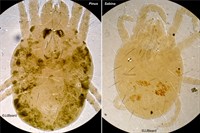
Fig. 1. Oligonychus ununguis adult female (non-type) - dorsal habitus.
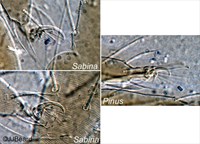
Fig. 2. Oligonychus ununguis adult female (non-type) - detail of empodia II.

Fig. 3. Oligonychus ununguis adult female (non-type) - detail of empodia I-IV (redrawn from Geijskes (1939)).
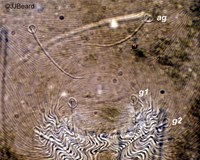
Fig. 4. Oligonychus ununguis adult female (non-type) - detail of pregenital striae.
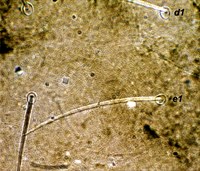
Fig. 5. Oligonychus ununguis adult female (non-type) - detail of pattern of dorsal striae between setae e1-e1.
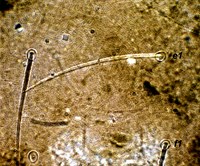
Fig. 6. Oligonychus ununguis adult female (non-type) - detail of pattern of dorsal striae between setae e1-f1.
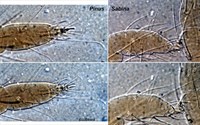
Fig. 7. Oligonychus ununguis adult female (non-type) - detail of number of proximal setae on tarsus I.
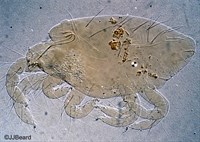
Fig. 8. Oligonychus ununguis adult male (non-type) - lateral habitus.

Fig. 9. Oligonychus ununguis adult male (non-type) - detail of empodium III.
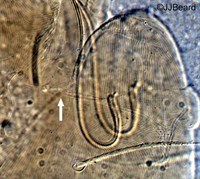
Fig. 10. Oligonychus ununguis adult male (non-type) - detail of peritreme (arrow indicates tip).
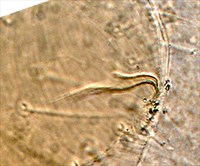
Fig. 11. Oligonychus ununguis adult male (non-type) - detail of aedeagus.
Material examined
non-types
Taxonomy
Subfamily Tetranychinae
Tribe Tetranychini
Common Name
Spruce spider mite
Distribution
+Australia, Austria, Belgium, Bermuda, Brazil, CIS, Canada, China, Colombia, Cuba, Czechoslovakia, Denmark, Finland, France, *Germany (Kingdom of Saxony), Greece, Hawaii, Hungary, Iceland, Italy, Japan, Korea, Mexico, New Zealand, Norway, Poland, South Africa, Spain, Sweden, Switzerland, Taiwan, The Netherlands, UK, USA
Taxonomy Changes
Tetranychus ununguis Jacobi 1905
Paratetranychus ununguis Jacobi 1905
Oligonychus ununguis (Jacobi) Hirst 1920
Tetranychus uniunguis Ewing 1917
Neotetranychus uniunguis (Ewing) McGregor 1919
Paratetranychus uniunguis (Ewing) McGregor 1950, synonymy Pritchard & Baker 1955
Oligonychus americanus Ewing 1921
Paratetranychus americanus (Ewing) McGregor 1950, synonymy Pritchard & Baker 1955
Paratetranychus pini Hirst 1924, synonymy Pritchard & Baker 1955
Oligonychus biotae Reck 1953, synonymy Mitrofanov et al. 1975
Paratetranychus inouei Ehara 1954, synonymy Ehara 1962
Oligonychus rollowi Reck 1956, synonymy Mitrofanov et al. 1975
Diagnosis
Female (Fig. 1)
- empodia I-IV slender, strongly curved claw, as long as proximoventral hairs (Figs 2, 3)
- empodial claws long on Australian material from Sabina; empodial claws short on Australian material from Pinus
- pattern of pregenital striae varies with description (Fig. 4):
- pregenital striae usually longitudinal, but vary to transverse (Pritchard & Baker 1955)
- pregenital striae transverse (Aust. material from Sabina and Pinus; Baker & Tuttle 1994)
- peritreme ending in simple bulb, slightly expanded (Fig. 10)
- dorsal striae transverse, except irregular oblique and longitudinal striae between setae e1-e1 and e1-f1 (Figs 5, 6)
- lobes on dorsal striae small, closely spaced
- lobes on ventral striae small
- number of proximal setae on tarsus I varies (Fig. 7):
- tarsus I with the sockets of four tactile setae and one solenidion proximal to socket of the proximal duplex seta (Aust. from Sabina)
- tarsus I with the sockets of three tactile setae and one solenidion proximal to the socket of the proximal duplex seta (Aust. from Pinus)
- tarsus I with the sockets of three-four tactile setae and one solenidion proximal to the socket of the proximal duplex seta
- number of proximal setae on tarsus II varies:
- tarsus II with the sockets of three-four tactile setae proximal to the socket of the duplex seta (Aust. from Sabina)
- tarsus II with the sockets of two tactile setae and one solenidion proximal to socket of the duplex seta (+ one tactile seta adjacent to base of duplex setae) (Aust. from Pinus)
- tarsus II with the sockets of four tactile setae and one solenidion proximal to the socket of the duplex seta
- dorsal opisthosomal setae f1 longer than setae f2
- tibia I-II 8(1+0), 5
- orange to black (Jacobi 1905: in summer, bright red to sanguineous red, dorsally mostly blackish)
- eggs with dorsal stipe
Male (Fig. 8)
- empodia I-IV as in female (Fig. 9)
- empodium I shorter and more stout than others
- peritreme ending in simple bulb (Fig. 10)
- tarsus I with sockets of three tactile setae and three solenidia proximal to the socket of the proximal duplex seta
- tarsus II with the sockets of three-four tactile setae and one solenidion proximal to the socket of the duplex seta
- tibiae I-II 11(4+0), 5
- tibiae I-II 10(3+0), 5 (Baker & Tuttle 1994)
- aedeagus ventrally directed; shaft narrow with dorsal and ventral margins parallel and sinuous; no anterior or posterior projection; ventral projection directed slightly posteriorly, abruptly tapered to form short, narrow, straight finger with truncate tip (Fig. 11)
- description of aedeagus varies in the literature:
- aedeagus ventrally directed, bent at right-angle to shaft, tapering gradually to elongate, narrow, truncate tip (length of ventrally directed part variable in length (Pritchard & Baker 1955))
- aedeagus with bent portion tapering little until near distal end where it abruptly narrows into short, thin portion with truncate tip (McGregor 1950)
- orange to black (Jacobi 1905: in summer, green-yellowish to yellow-reddish, dorsally mostly blackish)
Hosts
> 100 recorded species of host plant, mainly conifers, including: 7 Abies spp. (Pinaceae), Araucaria angustifolia (Araucariaceae), 5 Chamaecyparis spp., 3 Cupressus spp., 8 Juniperus spp. (Cupressaceae), 3 Larix spp., 15 Picea spp. including *Picea excelsa, *P. sitchensis, *P. alcockiana, 28 Pinus spp. (Pinaceae), 4 Quercus spp. (Fagaceae), Sabina sp. (Cupressaceae), 2 Sequoia spp. (Pinaceae), 2 Thuja spp. (Cupressaceae), 2 Tsuga spp. (Pinaceae)
Similar Taxa
Species recorded in Australia:
- Oligonychus coffeae (Nietner, 1861)
- Oligonychus ilicis (McGregor, 1917)
- Oligonychus mangiferus (Rahman & Sapra, 1940)
- Oligonychus punicae (Hirst, 1926)
Species not yet recorded in Australia:
- Oligonychus vitis Zaher & Shehata
Biology
This species is a serious pest of conifers throughout the world. Feeding causes the needles to turn brown. During severe infestations the trees appear brown and drop their needles, sometimes until the tree is bare, and seedlings and young trees can be killed. Large acreages of mature trees have been killed by this species of mite. Hemlock, when damaged by this mite, appears whitish or pale. Damage is generally more severe lower down on the tree than at the top.
Like other Oligonychus, this species overwinters as eggs, usually laid near the base of the needles and in other protected areas, but eggs are never laid on the needles themselves. Adults complete development in 11-23 days during summer. Young mites prefer the needles and shoots in the lower part of the tree crown, whereas adults may be found all over the tree. Adult females lay 45 eggs in a lifetime, which have a stipe, are greyish brown initially, becoming darker orange brown. Newly hatched larvae are pink, but then turn green. Adults are orange to black.
References
Ehara, S. (1954) Two new spider mites parasitic on Japanese conifers. Annot. Zool. Jpn. 27: 102-106
Ehara, S. (1962) Tetranychoid mites of conifers in Hokkaido. J. Fac. Sci. Hokkaido Univ. (ser. 6) Zool. 15: 157-175
Ewing, H.E. (1917) New species of economic mites. J. Econom. Entomol. 10: 497-501
Geijskes, D.C. (1939) Beiträge zur kenntnis der Europäischen spinnmilben (Acari, Tetranychidae), mit besonderer berücksichtigung der Niederländischen arten. Mededeelingen van de Landbouwhoogeschool te Wageningen (Nederland) 42(4): 1-68
Hirst, S. (1920) Revision of the English species of red spider (Genera, Tetranychus and Oligonychus). Proc. Zool. Soc. Lond. 4: 49-60
Hirst, S. (1924) On some new species of red spider. Ann. Mag. Nat. Hist. (ser. 9) 14: 522-527
*Jacobi, A. (1905) Eine Spinnmilbe (Tetranychus ununguis n. sp. ) als Koniferenschadling. Naturwiss. Z. Land. Forst. 3: 239-247
McGregor, E.A. (1919) The red spiders of America and a few European species likely to be introduced. Proc. U.S. Natl. Mus. 56: 641-679
Migeon, A. and Dorkeld, F. (2006-2017) Spider Mites Web: a comprehensive database for the Tetranychidae. http://www.montpellier.inra.fr/CBGP/spmweb
Mitrofanov, V.I. Bossenko, L.I. and Bitchevskis, M.Y.A. (1975) A key for determination of tetranychoid mites on coniferous tree. Latvian Sci. Res. Inst. probl. For. Latvijas Entomol. supp. 3: 1-41
Pritchard, A.E. and Baker, E.W. (1955) A revision of the spider mite family Tetranychidae. Pacific Coast Entomology Society Memoirs 2: 1-472
Reck, G.F. (1953) Research investigation on the fauna of the Tetranychidae in Georgia. Tr. Inst. Zool. Akad. Nauk Gruz. S.S.R. 11: 161-181
Reck, G.F. (1956) Novye vidy tetranihovyh klescej iz Vostocnoj Gruzii. Tr. Inst. Zool. Akad. Nauk Gruz. S.S.R. 15: 5-28
+Womersley, H. (1940) Studies in Australian Acarina, Tetranychidae and Trichadenidae. Transactions of the Royal Society of South Australia 64: 233-265
Zacher, F. (1913) Untersuchengen uber Spinnmilben. Mitt. Kais. Biol. Anst. Land-Forst. 14: 37-41
Notes
As the host plant records indicate, this species is a pine specialist. The material from other hosts, identified as O. ununguis, most likely represents different species.
See Notes for O. punicae for a discussion on this species-group.
Copyright © 2018. All rights reserved.